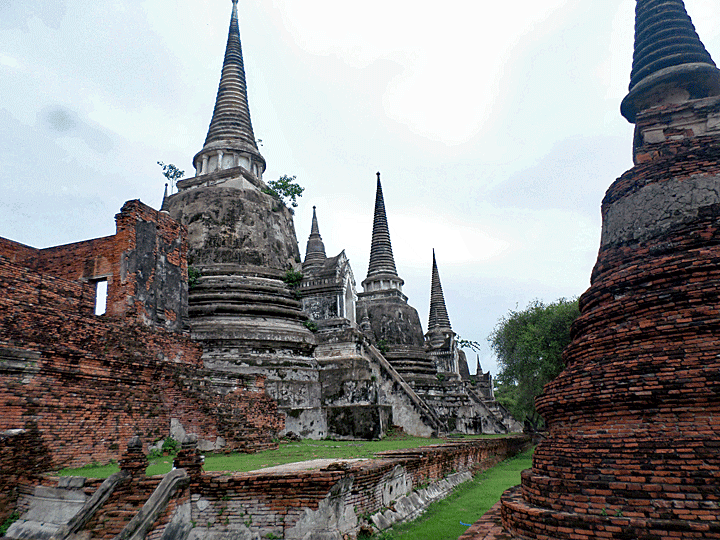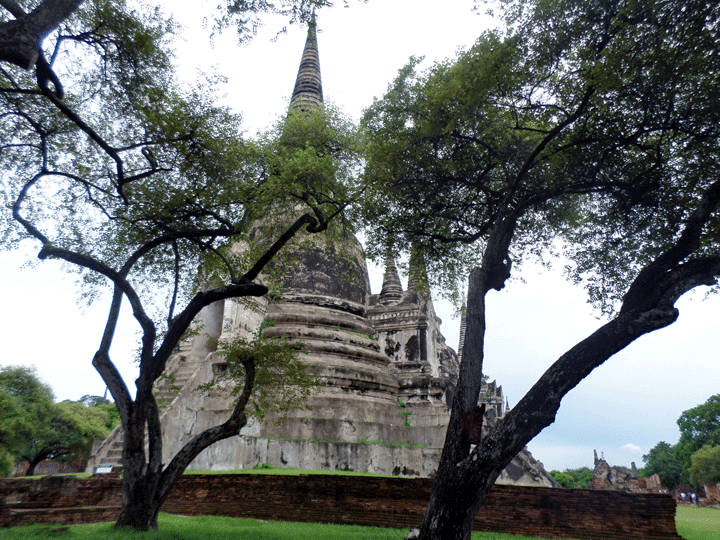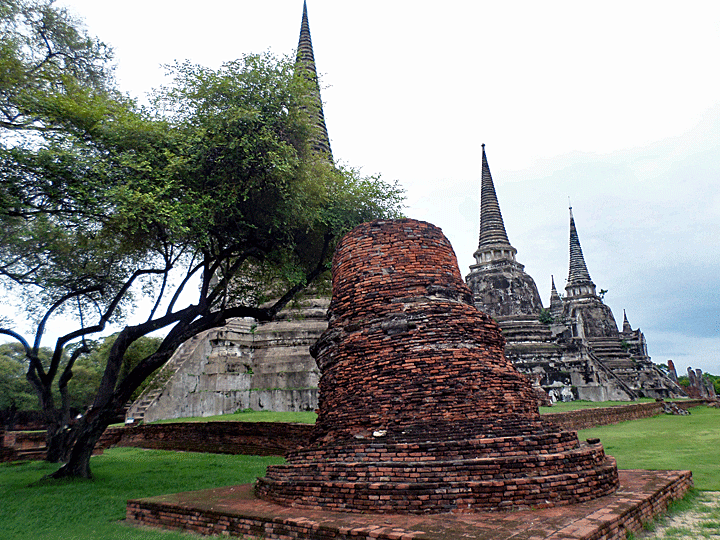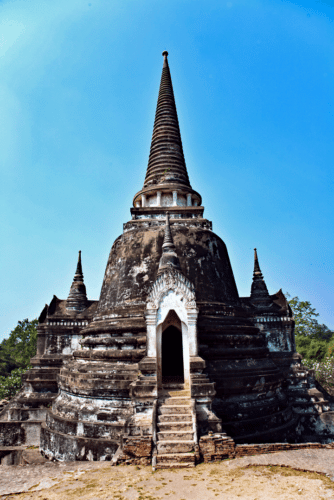The faded glory of Wat Phra Si Sanphet

When I want to introduce friends to what remains of the extraordinarily rich cultural history of AyutthayaI always take them first Wat phra si sanphet. It was once the holiest and most important temple in the kingdom. The imposing ruins of Wat Phra Si Sanphet in Ayutthaya to this day bear witness to the power and glory of this empire that captivated the first western visitors to Siam.
The construction of this huge temple complex was started around 1441 under the reign of King Borommatrailokanat (1431-1488) on the place where almost a century earlier, in 1350 to be precise, U-Thong (1314-1369), the first king of Ayutthaya built his palace. Borommatrailokanat had a new palace built on the north side of the city and so this site became available to build a royal temple. Wat Phra Si Sanphet – just like today Wat Phra Kaew on the palace grounds in Bangkok – was a royal temple and therefore not inhabited by monks. It was therefore used exclusively in religious ceremonies and became the most important spiritual center of the empire.

Borommatrailokanats' son Ramathibodi II (1473-1529) had two enormous bell-shaped stupas or chedis built in Sri Lankan style, but with Khmer porticos, on a terrace near the temple – which was probably the foundation of the original palace – in Sri Lankan style. of his deceased father and brother. King Borommaracha IV – who ruled Ayutthaya briefly between 1529 and 1533 – built a third chedi next to it that contains the ashes of Ramathibodi II. These chedis not only house the remains of these monarchs, but also contain Buddha statues and royal paraphernalia. Between the chedis there was always a mondop built on a square ground plan and crowned with a high spire in which relics were kept.

The name Phra Si Sanphet refers to a 16 meter high bronze and 340 kg gold-plated Buddha statue that was placed in 1500 in the great Wihan, the entrance to the temple complex, by King Ramathibodi II (1473-1529). You can still see the 8 meter wide plinth that had to support the 64 ton statue. The imposing Prasat Phra Narai at the rear of the temple had a cruciform ground plan and a high four-tiered roof. The whole complex, which also contained smaller shrines and salas, was surrounded by a high wall with a passageway in each of the four cardinal points. In the 1680s, the entire complex, which was beginning to show the first signs of decay, was radically renovated by King Borommakot (1758-1767). Nine years after his death, in XNUMX Ayutthaya was taken by the Burmese troops. It not only marked the end of the Siamese Ban Phlu Luang dynasty, but also the end of the once magnificent Ayutthaya. The city was sacked with fire and sword and utterly destroyed. The few surviving inhabitants were taken to Burma as slaves. Wat Phra Si Sanphet also did not escape the destruction and the ruins give us only a glimpse of the majestic character that this temple once exuded.

The first archaeologists and art historians to visit the ruins were French, who initiated research, especially in the period 1880-1890. Until the beginning of the twentieth century, this site was completely overgrown. In 1927, Wat Phra Si Sanphet became the first historical heritage to be protected and placed under the management of the Thai Fine Arts Department. Partial restoration and conservation of this site was realized in several phases, especially in the XNUMXs and XNUMXs. Only the chedi containing the ashes of Borommatrailokanat, just behind the Wihan, was spared the destruction and is therefore authentic. The other two were rebuilt in the context of the large-scale restoration. A beautiful scale model in a display case at the entrance to this complex gives a good idea of how Wat Phra Si Sanphet was once one of the most beautiful jewels in the crown of Ayutthaya….


Ah, temples, cathedrals, mosques… Another wonderful description. Can I hire you as a guide, Lung Jan?
Wat Phra Si Sanphet, in Thai script is พระศรีสรรเพชญ Phra and Si (or Sri) are titles and Sanphet means 'Know-all', of course only applicable to the Buddha.
Quote
'…. a royal temple and therefore not inhabited by monks…..”
That is not correct. Bangkok has 9 royal temples, several of which are inhabited by monks. The most famous is Wat Bowonniwet, where King Bhumibol and his son King Maha Vajiralongkorn stayed as monks for a number of weeks.
Dear Tina,
You are of course quite right about those royal temples... There are quite a few more of them throughout Thailand. I will learn to express myself more accurately in the future. What I actually wanted to say was that this temple, which, like Wat Phra Kaew, is an inseparable part of the crown domain - palace grounds, de facto did not have resident monks. A non-monastic tradition that, I was once told, dates back to the Sukothai period...;
An interesting piece of history of this venerable temple. Thanks for posting. Been to Ayutthaya several times. If only I had you by my side as a guide Lung Jan!
The dating of Ayutthaya monuments is mostly based on the dates given in the Royal Chronicles of Ayutthaya written in the early Rattanakosin period. Piriya Krairiksh, in his paper “A Revised Dating of Ayudhya Architecture”, draws attention to the possibility that the monuments we see today were built at a later period.
Piriya Krairiksh states that nowhere in the ancient documents is it stated that the ashes of King Borommatrailokanat and King Borommaracha III were each placed in a stupa, while there is also no indication of the location of these stupas nor any mention of a specific temple.
The oil painting of “Iudea” from c. 1659 in the Rijksmuseum in Amsterdam and the watercolor from Johannes Vingboons' atlas of 1665 does not show a stupa at the back of the royal vihara (wihan luang), and therefore he believes that the timing of the construction of the three stupas should be revised .
Referring to the "Plan of the Royal Palace of Siam" prepared by Engelbert Kaempfer, he concludes that the chedis seen on the plan were probably built between 1665 and 1688 during the reign of King Narai, as all these additional structures are missing from Vingboons' atlas. He also notes that the chedis on Kaempfer's plan are of the prasat (step form) type, and not the current bell-shaped Sinhalese type. Krairiksh writes that if we compare the current architectural layout of Wat Phra Sri Sanphet with Kaempfer's 1690 plan, nothing of the structures shown in this plan remains.
The Royal Chronicles of Ayutthaya records that King Borommakot ordered a complete renovation of Wat Phra Sri Sanphet in 1742 leading Krairiksh to assume that the earlier structures were demolished and replaced by the three Sinhalese-type stupas interspersed with three mandapas and laid out on an east-west axis according to a symmetrically designed master plan of the time.
Dear AHR,
It is quite possible that this concerns a later new construction, reconstruction or adjustment phase. The archaeological excavations that took place in Ayutthaya, especially in the 14s to the XNUMXs, show that these practices were commonplace. By the way, I myself was referring to the terrace on which the chedis stand, which may have been part of the original palace complex of U Thong, dating from the mid-XNUMXth century. For the dating I based myself on the official dating as it appears in the voluminous and detailed protection file that was drawn up by the Thai Fine Arts Department….